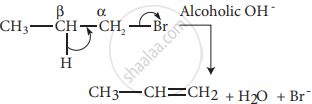Advertisements
Advertisements
प्रश्न
Give example for the following type of organic reaction.
β - elimination
उत्तर
In this reaction, two substituents are eliminated from the molecule, and a new C – C double bond is formed between the carbon atoms to which the eliminated atoms/groups are previously attached. Elimination reaction is always accompanied with a change in hybridisation.
Example:
n – Propyl bromide on reaction with alcoholic KOH gives propene. In this reaction, hydrogen and Br are eliminated.

APPEARS IN
संबंधित प्रश्न
For the following reactions
- \[\ce{CH3CH2CH2Br + KOH → CH3 – CH = CH2 + KBr + H2O}\]
- \[\ce{(CH3)3CBr + KOH → (CH3)3COH + KBr}\]

Which of the following statement is correct?
Homolytic fission of covalent bond leads to the formation of ______.
Which of the following species does not exert a resonance effect?
Which of the following carbocation will be most stable?
Assertion: Tertiary Carbocations are generally formed more easily than primary Carbocations ions.
Reason: Hyper conjucation as well as inductive effect due to additional alkyl group stabilize tertiary carbonium ions.
Which of the following species does not acts as a nucleophile?
Write a short note on hyperconjucation.
What is nucleophiles? Give a suitable example.
Show the heterolysis of a covalent bond by using curved arrow notation and complete the following equation. Identify the nucelophile.
CH3 – Br + KOH →
Show the heterolysis of a covalent bond by using curved arrow notation and complete the following equation. Identify the nucelophile.
\[\ce{CH3 – O – CH3 + HI →}\]
